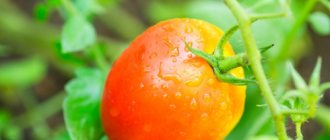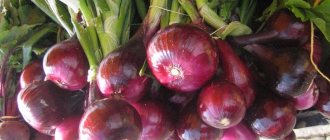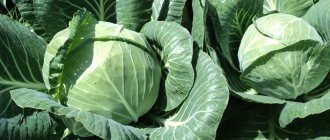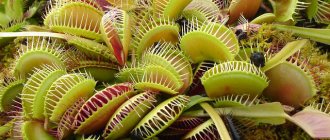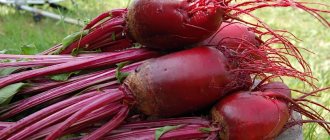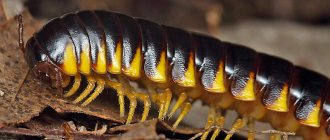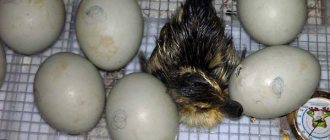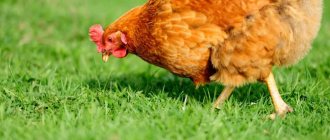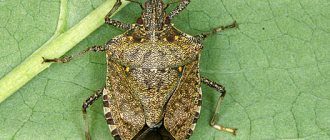Vegetable (also known as sweet or bell pepper) pepper is the favorite vegetable of most summer residents, second only to tomatoes and cucumbers in terms of planting volume. Juicy, large, thick-walled, rich in vitamins, productive - it grows well both in open and protected ground.
And among the various varieties and types of such sweet peppers, many housewives prefer “gogoshars”. Why? And what kind of name is this pepper anyway - an independent variety, a separate species, a whole group of plants?
Gogoshar is a group of varieties of thick-walled vegetable peppers, distinguished by wide, spherical, more or less ribbed, flattened fruits with a smooth surface and very juicy fleshy pulp with a characteristic sweet-spicy taste and bright aroma. The color of the fruit at technical ripeness is dark green, when fully ripe it is red in various shades or yellow. The wall thickness of this pepper reaches 7-10 mm, and the weight of the fruit is 80-150 g, depending on the variety.
This tomato-like (some say “pumpkin-like”) shape of the fruit has made the name pepper a common noun for the variety. Often, even in the characteristics of other varieties, you can find the description “gogoshary fruits”.
This pepper is most abundantly cultivated in Moldova, Ukraine, and Romania, where most of its varieties are bred (the name “gogoshary” actually comes from the Romanian gogoșar). For a long time, such varieties were mainly amateur, but in recent years they have firmly taken their place in commercial production.
In Russia, the varieties Gogoshar Mestny, Rubinovy 2 and Merishor are zoned from this group, although you can find seeds of other varieties on sale (for example, yellow gogoshar, novo gogoshar, mini gogoshar, etc.). Gogoshars also include the following varieties and hybrids: Grek, Olenka, Yablochny Spas, Golden Jubilee, Sweetie, Golden Tamara, Hostess, Olga, Aladdin's Lamp, Kolobok, Yellow Sun, etc.
Such pepper can be sold under local names: ratun, rotunda (ratunda), semi-hot pepper, Hungarian paprika.
Origin of the Gogoshary pepper variety
The Gogoshary sweet pepper variety was bred at the Moldavian Research Institute of Vegetable Growing during breeding work. Employees gave the new culture resistance to many diseases and pleasant taste.
Pepper has become widespread in Moldova, the western and southern parts of Ukraine, and northern Romania. It is often called ratunda pepper.
Gogoshary pepper seeds
Gogoshary pepper bush
Gogoshary pepper takes on the taste of neighboring vegetables
Pinching the ovaries
The gardener will definitely need to pinch the ovaries, which, although it reduces the number of ripening fruits, significantly extends the harvest period and improves the taste of pepper grown in the beds. This pinching prevents thickening of the bush, the plant does not waste energy on the formation of green mass, and the development of various fungal and infectious diseases is prevented. It is best to perform this pinching of the ovaries when the first ovaries appear, and subsequently the gardener needs to control the number of fruits on the plant at the same time.
Description and characteristics
This is a very heat-loving plant. Can be planted in open ground in warm climates. In other regions of the country, only greenhouse cultivation is suitable. The temperature during cultivation should not be lower than +16 degrees. From the cold, the shoots freeze, the flowers and ovaries fall off.
The growing period is from 100 to 130 days. Productivity is good. When grown in a greenhouse with proper care, you can get up to 9 kg per square meter. m.
Description of the bushes
This variety of peppers has low and not spreading bushes, moderately branched. They can reach a height of 50 cm and a width of up to 45 cm.
It can be grown without the use of additional support. Experienced summer residents recommend placing pegs under the branches during a bountiful harvest so that they do not break off under the weight of the fruit. The branches are fragile, so additional support will not be superfluous.
Fruit characteristics
Gogoshary peppers have small flattened fruits, similar to pumpkins. Ribbed, have 4 chambers. The color can be red, yellow or orange.
The main advantages of the fruit:
- juicy dense pulp up to 1 cm thick;
- convenient weight from 50 to 140 g;
- the taste is sweet without bitterness;
- low calorie content;
- high content of vitamins;
- gradually ripen when collected.
The stalk of peppers is powerful and strong, so many of the fruits are directed upward.
Application
Housewives prefer Gogoshary peppers because of their unusual shape and thick, fleshy wall of the fruit. You can use the vegetable in first and second courses, bake it, prepare sauces with it, marinate it according to the classic version and with honey.
The small seed chamber does not make it possible to stuff peppers, but such recipes are also available. Gogoshars are stuffed not only with meat, but also with stewed apples, zucchini, onions and lemon.
Peppers of this variety can be stored fresh for a long time in a cool room. It is picked unripe, before the color changes from green to red or yellow. Gradually he will mature, the time will come to eat him. For storage, the fruits can be cut and frozen.
Gogoshary pepper is an easy variety to grow and use. For this reason, it is popular among summer residents; housewives are happy to purchase it.
Diseases and pests
Varietal peppers, unlike hybrid ones, are more often affected by diseases. These are mainly fungal diseases, such as gray and white rot, late blight, cladosporiosis, fusarium, powdery mildew, etc. The roots of peppers can be affected by rot when watered with cold water.
Of the pests that attack peppers in open ground, the Colorado potato beetle is especially dangerous. Under favorable conditions, it can multiply greatly and cause great damage to pepper plantings. To prevent the spread of this pest, you do not need to plant peppers next to potatoes.
Among other pests, Gogoshar pepper can be affected by spider mites, aphids, mole crickets, and slugs.
Important! If there is a large infestation of aphids or Colorado potato beetles, it is advisable to use pesticides.
Varieties
The variety has many varieties, which allows summer residents to choose the parameters at their discretion. Characteristics differ in color, appearance, ripening period, and fruit weight.
Ratunda
A classic representative of the variety. The color of the fruit is bright red, the shape resembles a small pumpkin, as it is flattened at the top and bottom. The taste of Ratunda pepper has a specific pungency, but there is no bitterness. The walls of the fruit are not thick, up to 0.5-07 cm, the average weight of peppers is up to 120 g.
Ruby
This variety can tolerate lower temperatures. The fruits are round with pronounced ribs. Color from dark red to brown. The walls of the fruit are juicy and fleshy, reaching a thickness of 1 cm. The average weight of peppers is up to 150 g.
Kolobok
The fruits are ball-shaped, up to 8 cm high, weighing about 150 g. They reach maturity 135 days after sowing. The pulp is dense, juicy, more than 1 cm.
The initial color is green; as the peppers ripen, they turn red. Productivity is average, up to 4 kg per 1 sq. m. The taste is sweet. Excellent for canning as it does not lose its shape when cooked.
Olenka
High-yielding variety. From 1 sq. m harvest up to 9 kg of peppers. Experts recommend growing this variety in a greenhouse. The color of the fruit changes as it ripens from green to burgundy; the pulp has a sweet taste with a pleasant aftertaste. It is successfully used fresh and canned.
Sweetie
The fruits are small, weighing up to 60 g. The original shape is wide at the top, with a pointed tip at the bottom. The pulp is sweet, the walls of the fruit are up to 7 mm thick. During cutting, a characteristic pleasant aroma is felt.
An early ripening variety, it takes 90 days to ripen. Increased resistance to diseases. With proper care, you can harvest up to 1.5 kg of vegetables from one bush. Peppers of this variety are often canned whole.
Fragrant golden anniversary
The fruits are round in shape with slightly pronounced ribs. The weight of one pepper exceeds 200 g. The pulp is sweet and juicy. At the growth stage, the fruit is green, but by the time it ripens it becomes yellow-orange.
Original Kolobok
The variety has small bushes, up to 40 cm in height. The fruits form early and are stored well in a cool room. The ripening period is 130 days. The fruits are smooth, weighing from 130 to 190 g. The pulp is juicy, dense, up to 6 mm thick. For 1 sq. m you can grow up to 10 kg of peppers of this variety.
Golden Tamara
Large fruits up to 220 g. The pulp is juicy, the wall thickness is more than 1 cm. Ripe peppers have a light green tint. The ripening speed is 135 days. High yield. From 1 sq. m you can collect 8 kg of vegetables.
Rich Ruby
It takes a long time to ripen up to 180 days. It has an unusual aroma and pleasant taste. A good harvest is obtained only in the southern regions. The weight of the fruit reaches 190 g, the thickness of the pulp is up to 1 cm.
Pros and cons of the variety
The wide distribution of this variety is due to a number of undoubted advantages.
- High yield from one bush.
- Thick fleshy wall.
- Ability to ripen.
- Good transportability.
- Harmonious sweet taste.
- Convenient form for cooking, especially for stuffing.
At the same time, the variety also has disadvantages: it is susceptible to root rot, is affected by some pests, and likes abundant watering.
Features of cultivation
To get a good harvest, you need to take into account all the subtleties of the variety when planning agricultural work. The main feature of Gogoshary peppers is considered to be easy pollination. To obtain a pure taste, you need to plant this variety away from other types of peppers.
Deadlines
The optimal growing time for each region will be different, depending on the climate. Gogoshary peppers are mid-season varieties; they should last about 90 days at home. Experienced vegetable growers recommend sowing seeds for seedlings 10-15 days earlier than other varieties of peppers. The best time to work is the end of February - the first days of March.
Seedlings should be transplanted into the ground when the soil warms up to +16 degrees. Dates are approximately from mid-May to June. You can plant seedlings in a greenhouse or open ground.
The readiness of seedlings can be determined by their appearance:
- the stem became dense and grew to 10 cm;
- 4 true leaves appeared;
- the root system is quite developed.
Under such conditions, the seedlings successfully adapt to a new location and take root well.
Land preparation
For seedlings, the soil must be fertile; the number of fruits and their taste depend on this. You can buy earthen mixture in the store, but it is better to prepare it yourself.
To do this, take meadow soil, cow manure compost, river sand in proportions 3:3:3. Manure and soil will ensure good fertility, and sand will provide reliable drainage. Mix the ingredients and pour into prepared containers.
Regular common containers are not suitable for Gogoshary peppers. Its root system is very sensitive and does not tolerate transplantation. If the roots are damaged, the plant stops growing. It’s better to take individual plastic pallets or pots made of peat crumbs.
Before planting seedlings, the soil is disinfected to get rid of bacteria. There are several ways to do this:
- steaming;
- potassium permanganate solution;
- roasting in the oven.
To steam, pour boiling water over the soil and let it cool. The solution of potassium permanganate should be used one day before sowing. Take a grain of potassium permanganate and dissolve it in warm water until you obtain a saturated solution. Pour it over the ground and let the water drain.
To calcinate, scatter the soil on a baking sheet no more than 10 cm high. Heat for 20 minutes at a temperature of +30 degrees. Cool the ground, you can sow the seeds.
Preparing and sowing seeds
Before planting, you need to calibrate and select good quality seeds. Take 1 liter of water, dissolve 1 large spoon of salt in it. Place pepper seeds in water and shake. Good, full-bodied seeds that will produce high-quality seedlings will fall down. Empty grains will remain floating. They are poured out with water, and those remaining at the bottom are used.
Seeds need to be treated before sowing. This procedure will get rid of pathogens and stimulate the physiological processes necessary for growth.
Algorithm for preparing Gogoshary pepper seeds:
- Place the seeds for 30 minutes in a weak solution of potassium permanganate.
- Place the seeds on paper towels for 10 minutes.
- Place 2 layers of cotton cloth or gauze in a saucer, pour water, and put pepper seeds there.
- After 2 days, the shell of the grains will crack and they can be planted in the ground. It is no longer possible to store such seeds.
- In the prepared soil, make grooves 2 cm deep with a pencil. Plant the seeds at a distance of 5 cm from each other, sprinkle with soil.
- Place containers with seedlings in a well-lit place, maintain the optimal temperature for growing from +24 to +26 degrees.
- Daylight hours can be extended if desired using a seedling lamp.
Experts do not recommend moving containers with seedlings to brighter places. It is better to create a greenhouse effect by placing glass on top or stretching film. When the first shoots appear, there is no need for a greenhouse.
Picking seedlings and care
For good root development and to prevent excessive stretching of the plant, it is necessary to pick. It is done after the appearance of 3 leaves. Carefully pry the sprout together with the earthen lump and move it to a previously prepared separate container with fertile soil.
After transplanting, young peppers may be drooping because the plant is under stress. To make it easier to get used to the new environment, place containers with seedlings in partial shade. In a week the normal state will be restored.
Watering
In the first month of growth, watering should be minimal. During this period, pepper seedlings are especially vulnerable to the fungal pathology “black leg”. This dangerous disease can destroy all sprouts within a day. The reasons are low temperature and waterlogged soil.
For seedlings, minimal watering at the root is sufficient. The best time would be early morning and evening. The water should be settled and warm. The leaves must remain dry. As the plant grows and gains green mass, the danger of this disease disappears; you can water more often, three times a week.
Transplanting seedlings into the ground
2 weeks before transplanting into open ground, seedlings need to be hardened off. To do this, take the containers with sprouts out into the fresh air for a while or open the windows. The amount of time for such procedures should increase daily.
When the temperature stays + 16 degrees day and night, the time for night frosts will pass, and it will be possible to plant seedlings in open ground. For 1 sq. m should accommodate no more than 5-6 plants. Make a distance of 60 cm between rows.
Temperature and lighting
Heat-loving peppers grow well at temperatures from +24 to +26 degrees. When these indicators decrease, plant growth slows down, flowers and ovaries may fall off.
Gogoshary peppers are very demanding on lighting. In sunny summers, their yield increases, and in cloudy weather it decreases. Vegetable growers do not recommend planting them in the shade of spreading trees.
Sowing
Peppers of this variety are sown for seedlings in early March. Before sowing, I soak the seeds and keep them near the radiator for two days: they hatch and then germinate faster. Recently, I immediately sow in separate cups, at first even in disposable glasses, so that the seedlings take up less space.
| Tip You can prepare the soil for sowing yourself by mixing purchased soil with garden soil and coconut fiber. |
Photo: Variety Sweet Yellow.
You need to sow in moist soil, previously irrigated with water from a sprayer. To create greenhouse conditions, the seedlings are covered with a thin film.
Caring for the Gogoshary pepper variety in open ground
Summer residents get high yields of peppers if they follow basic agrotechnical rules.
Watering and fertilizing
To obtain a rich harvest, peppers need not only watering, but also irrigation. Constant watering promotes the development of a strong root system, good plant growth, and fruit formation.
After transplanting into the ground, water the peppers every 10 days. Each plant needs to spend up to 3 liters of water. Irrigation methods: sprinkling and drip irrigation.
In hot weather, leaves lose moisture, reducing the flow of nutrients to them. They wither and dry up. Low air humidity and high air temperature provoke shedding of flowers and the end of fruiting.
Sprinkling can correct the situation. This increases the air humidity around the plant to 70%, the soil cools, the elasticity of the leaves is restored, and the activity of all life processes is resumed.
Twice during the summer the plants are fed with liquid fertilizers. The most effective feedings:
- on bird droppings;
- on nettles.
Bird droppings fertilizer
To prepare bird droppings fertilizer, take half a bucket of dry or liquid droppings. Add water and stir. Close the top well to prevent nitrogen from evaporating, and place in a sunny place. For better fermentation, stir the contents daily.
After a week, the feeding is ready. It needs to be diluted so as not to burn the roots of the plants. For 10 liters of water, take 0.5 liters of concentrated bird droppings fertilizer. After stirring, water at the root. For one bush you need 2 liters of fertilizer at a time.
Fertilizers for nettles
To make nettle fertilizer in a barrel, place the plant in half the volume of the container. Add water to the top, close the lid. Place in a sunny, windless place. To release carbon dioxide, stir the contents every day.
After 10 days, the fertilizer will be completely prepared. Immediately before use, it must be diluted with water in a ratio of 1:10. Each bush requires 2 liters of solution.
Liquid fertilizers are convenient to use in the country. They are easy to prepare yourself and can be used for a long time as needed.
Hilling and loosening the soil
After transplanting into open ground, plants need to be loosened periodically. This saturates the soil with oxygen and helps kill weeds. Loosening is carried out between rows; mulching is used for the root zone. The roots of this plant are too close to the surface and can be damaged when loosened.
The first weeding is carried out 2 weeks after planting in open ground, the second should be done after another 2 weeks. Hilling is carried out together with her. It is necessary for the formation of additional shoots at the roots. This increases the productivity of the plant. Further weeding is done if necessary. During loosening, it is important not to destroy the mound created during hilling.
Formation and care of bushes
As the pepper bush develops, growth and fruit set need to be regulated. The more ovaries form on the plant, the smaller the peppers will be in weight. If a summer resident wants to grow large fruits, then he needs to trim off the excess ovary. In the first half of August, it is recommended to cut off all the flowers from peppers, because the harvest from them will not have time to ripen before the onset of cold weather.
If in July the air temperature rises above 30 degrees, then the flowers of Gogoshary peppers will become sterile. Fruits will not form. To avoid this situation, cover the beds with plants with white agrofibre (spunbond). This will shade and cool the peppers.
Features of care after planting seedlings in the ground
The gardener will receive a good pepper harvest if he adheres to cultivation techniques: timely loosening, hilling, irrigation, fertilization and protection from diseases and pests.
The crop has high lighting requirements; in sunny summers the yield increases significantly, but in cloudy and rainy summers it decreases. This crop will not bear fruit well in shade or partial shade, so it is not advisable to place pepper beds near trees.
Watering and fertilizing
It is impossible to get a high yield of pepper without abundant irrigation. Regular watering develops a powerful root system and a developed bush on which large and well-formed peppers grow.
Harvest and storage
The first fruits ripen by mid-July. It is better to remove them so that they do not delay the ovary of the next peppers. It is better to store collected vegetables in a cool, dry place.
If you need to transport Gogoshary peppers over long distances, their ripening period is postponed for this purpose. In this case, remove the unripe green fruits and place them in cardboard boxes with holes for air movement. After a few weeks, the fruits will acquire yellow or red shades characteristic of the variety.
Care
Gogoshary pepper requires optimal growing conditions. They are the key to high yields.
Seedling care
The plant is grown using the seedling method. To grow strong and healthy seedlings, we must take proper care of them. This process includes the following steps:
- like watering;
- loosening;
- dive;
- feeding;
- maintaining appropriate temperature and lighting.
Watering
Water frequently but sparingly when the top layer of soil is dry. The water should be warm and stable.
Loosening
Loosening must be done very carefully so as not to catch the roots. This is not done if the sprouts are less than 1-2 cm.
Picking
Gogoshary pepper is one of those plants that require picking seedlings. Produced when the sprouts have 2-3 leaves. This process is important because the plant has a strong root system. Care must be taken not to damage the sensitive roots.
Additional fertilizers
Feed the seedlings within 12-14 days after emergence. For this purpose, liquid complex fertilizers are used. They are used strictly according to the instructions.
Temperature conditions
Grow seedlings in a warm place, because Gogoshary pepper is one of the plants that loves it very much. Seedlings germinate at 25-26°C, then you can maintain indicators at 18-22°C. The temperature gradually decreases, so there are no sudden changes. Otherwise, the sprouts may slow down their growth or die completely. Two weeks before planting, seedlings should be hardened off. To do this, containers with them are taken outside in a shaded place for 1-2 hours every day.
Care after landing
To prevent the ovaries and flowers from dropping, we must prevent the soil from drying out. Moisturize it regularly. Warm water can also be added between rows to increase humidity.
It is necessary to loosen the soil, but carefully so as not to damage the roots, because they are not deep. Instead of loosening, you can mulch. Straw, sawdust, and dried grass are used as mulch. Place a layer of 2-3 cm.
It is also necessary to carry out weeding periodically. Weeds are pulled out only between rows; this should not be done near the roots.
The description of the variety states that Gogoshary pepper needs high-quality additional feeding. It is performed in 3 stages:
- after landing in a permanent place;
- during the flowering period;
- during the appearance of the fetus.
Fertilized with nitrogen, complex, phosphorus agents. The dosage should be determined strictly in accordance with the instructions so as not to harm the roots of the sweet pepper.
The plant requires staking because the fruits are quite large. They load the bush heavily. When harvesting vegetables, it is necessary to hold the stem so as not to damage the entire bush. The first vegetables are harvested when they are at the technical maturity stage.
Advantages and disadvantages
Each variety has its own negative and positive qualities. The advantages can be noted as follows:
- compact bushes;
- excellent taste characteristics;
- neat shape of the fruit;
- high productivity;
- mid-season;
- wide application;
- resistance to diseases such as fusarium, rot, viral mosaic;
- ability to ripen when picked;
- suitability for storage and transportation
- low calorie content;
- easy care.
The variety has disadvantages:
- the need for regular fertilization;
- drought intolerance;
- inadmissibility of poor lighting;
- fragility of stems;
- exposure to pests.
Deficiencies can be corrected by proper plant care.
How to plant?
Gogoshar varieties are easily cross-pollinated, so to obtain a clean harvest, the crop is planted away from other sweet and bitter peppers. Choose a site for growing vegetables that is well lit by the sun and protected from the wind.
Crop rotation plays an important role.
The crop grows well after the following vegetables:
- cabbage;
- beet;
- onion;
- carrot;
- cucumber.
To reduce the likelihood of infection with diseases characteristic of the nightshade family, peppers are not grown after potatoes and tomatoes.
Soil and seed preparation
To grow seedlings, purchase a substrate from a specialized store or prepare it yourself by mixing turf soil, peat and humus in a ratio of 2:2:1.
Sawdust or coarse sand is also added to the mixture. Peppers are grown in seedlings. Before sowing, allow the soil to warm up well. The soil must be disinfected by calcining it in the oven for 10-15 minutes or by watering it with a 1% solution of potassium permanganate.
The seeds are also disinfected by placing them in a 1% solution of potassium permanganate for 20-30 minutes and then rinsing them with clean water. For germination, seed material is wrapped in damp cotton cloth for 2-3 days.
As the gauze dries, the seeds are moistened. Sowing is done in moist soil. The soil is moistened with a sprayer. To create greenhouse conditions, the container with seeds is covered with glass or film.
The seedlings are placed on a warm, illuminated windowsill before being planted in a permanent place of growth.
For your information. Seedlings do not tolerate changes in location, temperature and light. Peppers are sown at the end of February.
Reviews
★★★★★
Margarita, 37 years old, manager, Moscow region. The pepper came to us by chance, we were treated to it by friends.
We left a few seeds for planting; we really liked the taste and shape. It consistently gives a good harvest, is well stored - we are satisfied. ★★★★★
Tatyana, 43 years old, accountant, Chelyabinsk. This pepper is a favorite in our family.
I really like the Kolobok variety. Small, neat, juicy, and very convenient to prepare. It is not difficult to grow, it grows well in warm climates and produces a large harvest. ★★★★★
Stanislav, 67 years old, pensioner, Moscow. I have been growing Gogoshary peppers for more than 10 years.
The best variety of sweet pepper. Juicy, thick-walled, compact in shape. The whole family loves it and we recommend it to others too. Hide
Add your review
Gogoshary pepper is popular among gardeners due to its high yield, excellent taste and original appearance. Many beginners try to plant it on their plots. Complete information will be useful for proper care and obtaining a good harvest of vegetables.
0
0
Copy link
Photo
In order to better understand what Gogoshar is, you can look at the photographs below.
Olenka
Gogoshar Olenka appeared in 2006. This is the work of Smolensk breeders. The originator of the variety is. Capsicum early. They wait 100 days from sowing to harvesting. The fruit is strongly ribbed, glossy, tomato-shaped. The berries are not very large, but sweet:
- pepper variety Olenka grows up to 80 cm. It has well-developed lateral eyelids;
- the fruits are small, 90 g, but the walls are very fleshy and juicy, 7 mm;
- the bushes are strewn with pepper. Productivity 9 kg/m2.
More on the topic: How does Ali Baba pepper grow?
When growing peppers, it is recommended to use the “Humates +” fertilizer. It contains humic acids, which increase plant immunity, normalize metabolic processes in tissues, strengthen the ovary and increase productivity. Fertilizer is added to the irrigation liquid, 100 ml/10 l.
Productivity and ripening time
The productivity of Gogoshar is high. Fruits that reach technical maturity have a green color; in a biological state, they acquire different shades of red, from scarlet to ruby, or golden yellow.
The ripening time for different varieties differs slightly, but in most they correspond to mid-ripening. To obtain fruits, it will take approximately three and a half months from the date of sowing the seeds in the ground, from the moment of emergence of seedlings - approximately 110-115 days. Mass ripening of fruits occurs in July, active fruiting continues in August.
Where is it recommended to grow
All varieties of this variety are heat-loving, so you can count on abundant fruiting if Gogoshar is planted in the southern regions of Russia, Ukraine and Moldova.
The optimal average temperature in summer should be from +25 to +29 C. With sufficient sunlight and fresh air, fruits actively form and their taste improves.
Gogoshars can also be grown in greenhouses; provided normal conditions are created, the yield will also be high.
Ruby necklace
Another representative of the Gogoshars is the capsicum variety Ruby Necklace. The berries are round in shape and have a smooth, glossy surface. It is grown everywhere, in greenhouses and open areas. Medium spreading plant, grows up to 80 cm:
| № | Helpful information |
| 1 | pepper of the Ruby Necklace variety is green at the time of technical ripeness. Turns red when fully ripe |
| 2 | berries are not very large, 60 g, but very fleshy, 8 mm |
| 3 | the productivity of Gogoshar Ruby Necklace pepper is 8.4 kg if plants are grown under film |
The plant is protected by breeders from verticillium and viral diseases. Gardeners recommend prevention against infections. The bushes are irrigated with biofungicides that do not change the metabolic processes in plant tissues.
These include “Fitosporin”, “Fitolavin”. Folk remedies include infusion of ash or onion peel. Treatment is carried out once every 3 weeks.
